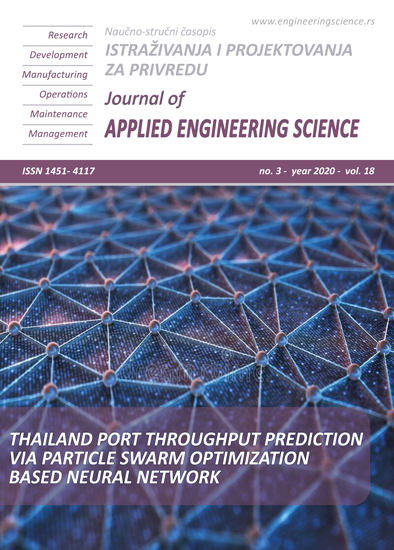ORCHID SPECIES ANACAMPTIS MORIO AS A POTENTIAL BIOREMEDIATOR OF As, Cd AND Pb
Abstract
In this study concentration of toxic elements As, Cd, and Pb were determined in different soil types and belonging orchid species Anacamptis morio vital parts, in order to examine accumulation patterns and provide new insights about the potential use of this orchid in bioremediation technology. The soils developed on limestone, serpentine, and the chert were subjected to the BCR sequential extraction. Samples of orchid root and tuber, as underground parts, and stem, leaves, and inflorescence, as above-ground organs, were also analyzed for the content of As, Cd and Pb. During this research, it was observed that metal content in soil is directly proportional to its content in the plant, more specifically in roots, which suggest that A. morio can potentially be used in the phytostabilization of contaminated sites. Values for BCF factors showed Cd immobilization in roots regardless of the soil type. A certain level of arsenic was transferred from root to leaves indicating the potential for accumulation of this element into aboveground organs. Assessment of the phytoremediation potential of this orchid or another plant species from diverse environments is important as it provides information about the possibility of their future application in environmental remediation programs.
References
/2/ Bañuelos, G., Ajwa, H., (2008), Trace elements in soils and plants: An overview, Toxic/Hazardous Substances, and Environmental Engineering, 34, 951-974., DOI: 10.1080/10934529909376875
/3/ Bakircioglu, D., Kurtulus, Y., Ibar, H., (2011), Investigation of trace elements in agricultural soils by BCR sequential extraction method and its transfer to wheat plants, Environmental Monitoring and Assessment, 175, 303–314. DOI: 10.1007/s10661-010-1513-5
/4/ Mani, D., Kumar, C., (2014), Biotechnological advances in bioremediation of heavy metals contaminated ecosystems: an overview with special reference to phytoremediation, International Journal of Environmental Science and Technology, 11, 843–872., DOI: 10.1007/s13762-013-0299-8
/5/ Ali, H., Khan, E., Sajad, M., (2013), Phytoremediation of heavy metals—Concepts and applications, Chemosphere, 91, 869-881., DOI: 10.1016/j.chemosphere.2013.01.075]
/6/ Lasat, M., Phytoextraction of Toxic Metals: A Review of Biological Mechanisms (2002), Journal of Environmental Quality, 31 (1), 109, DOI: 10.2134/jeq2002.1090
/7/ Mendez, M., Maier, R., Phytostabilization of Mine Tailings in Arid and Semiarid Environments—An Emerging Remediation Technology (2008), Environmental Health Perspectives, volume 116(3), 278-283, DOI: 10.1289/ehp.10608
/8/ Tica, D., Udovic, M., Lestan, D., (2011), Immobilization of potentially toxic metals using different soil amendments, Chemosphere, 85, 577-583., DOI: 10.1016/j.chemosphere.2011.06.085
/9/ Naidu, R., Bolan, N., Megharaj, M., Juhasz, A., Gupta, S., Clothier, B., Schulin, R., (2008), Chemical bioavailability in terrestrial environments, Developments in Soil Science, 32, 1-6, DOI: 10.1016/S0166-2481(07)32001-1
/10/ Fernández Alborés, A., Pérez Cid, B., Fernández Gómez, E., Falqué López, E., Comparison between sequential extraction procedures and single extractions for metal partitioning in sewage sludge samples (2000), Analyst, 125, 1353-1357, DOI: 10.1039/B001983F
/11/ Ure, A., (1996), Single extraction schemes for soil analysis and related Applications, Science of The Total Environment, 178 (1-3), 3-10, DOI: 10.1016/0048-9697(95)04791-3
/12/ Rao, C., Sahuquillo, A., Lopez Sanchez, J., (2008), A Review of the Different Methods Applied in Environmental Geochemistry For Single and Sequential Extraction of Trace Elements in Soils and Related Materials, Water, Air, and Soil Pollution, 189, 291–333, DOI: 10.1007/s11270-007-9564-0
/13/ Tlustoš , P., Száková , A., Pavlíková, D., (2005), A comparison of sequential extraction procedures for fractionation of arsenic, cadmium, lead, and zinc in soil, Central European Journal of Chemistry, 3, 830–851, DOI: 10.2478/BF02475207
/14/ De Agostini, A., Caltagironeb, C., Careddaa, A., Cicatellic, A., Cogonia, A., Farcid, D., Guarinoc, F., Garaub, A., Labrae, M., Michele Lussua, M., Dario Pianoa, D., Sannaa, C., Tommasie, N., Vaccab, A., Cortis, P., (2020), Heavy metal tolerance of orchid populations growing on abandoned mine tailings: A case study in Sardinia Island (Italy), Ecotoxicology and Environmental Safety, 189, 111018, DOI: 10.1016/j.ecoenv.2019.110018
/15/ Filimonova, E., Lukina, N., Glazyrina, M., Borisova, G., Maleva, M., Chukina, N., (2019), Endangered orchid plant Epipactis atrorubens on serpentine and granite outcrops of Middle Urals, Russia: A comparative morphophysiological study, AIP Conference Proceedings 2063, 040016, DOI: 10.1063/1.5087348
/16/ Filimonova, E., Lukina, N., Glazyrina1, M., Borisova, G., Kumar, A., Maleva, M., A comparative study of Epipactis atrorubens in two different forest communities of the Middle Urals, Russia (2019), Journal of Forestry Research, DOI: 10.1007/s11676-019-01010-y
/17/ Đorđević, V., Tsiftsis, S., Lakušić, D., Stevanović, V., (2014), Niche analysis of orchids of serpentine and non-serpentine areas: Implications for conservation, Plant Biosystems – An International Journal Dealing with all Aspects of Plant Biology, 150, 710-719, DOI: 10.1080/11263504.2014.990534
/18/ Djordjević, V., Tsiftsis, S., Patterns of orchid species richness and composition in relation to geological substrates (2019), Wulfenia 26, 1–21
/19/ D.C., Ghosh, M., Singh, S. P. (2005), A comparative study of cadmium phytoextraction by accumulator and weed species. Environmental Pollution, 133: 365–371., DOI: 10.1016/j.envpol.2004.05.015
/20/ Gupta, S., Nayek, S., Saha, R.N., Satpati, S. (2008): Assessment of heavy metal accumulation in macrophyte, agricultural soil, and crop plants adjacent to discharge zone of sponge iron factory, Environmental Geology, 55, 731–739., DOI: 10.1007/s00254-007-1025-y
/21/ StatSoft. (2007). Statistica for Windows, version 8.0. Tulsa:StatSoft Inc
/22/ Kabata-Pendias, A. (2001): Trace Elements in Soil and Plants, (2nd ed.), Boca Raton, CRC Press, Washington, D.C.
/23/ Babalonas, D., Karataglis, S., Kabassakalis, V., (2008), Zinc, Lead and Copper Concentrations in Plants and Soils from two Mines in Chalkidiki, North Greece, Journal of Agronomy and Crop Science, volume 21, 707-713. DOI: 10.1111/j.1439-037x.1987.tb01150.x
/24/ Jurkiewicz, A., Turnau, K., Mesjasz-Przybylowicz, J., Przybylowicz, W., and Godzik, B., (2001), Heavy metal localization in mycorrhizas of Epipactis atrorubens (Hoffm.) Besser (Orchidaceae) from zinc mine tailings, Protoplasma, volume 218, 117-124. DOI: 10.1007/BF01306601
/25/ Shefferson, R., Kull, T., Tal, K., (2008), Mycorrhizal interactions of orchids colonizing Estonian mine tailings, American Journal of Botany 95(2), 156-164., DOI: 10.3732/ajb.95.2.156

